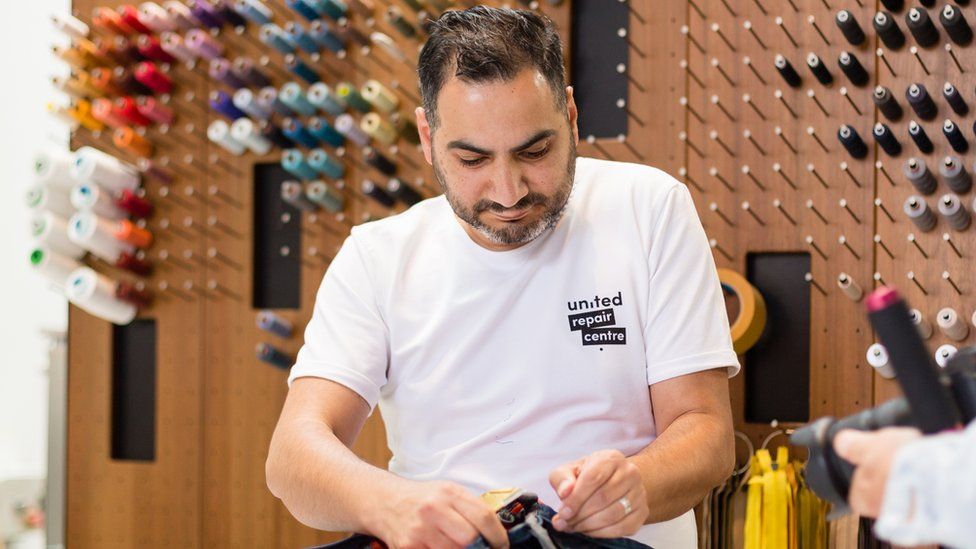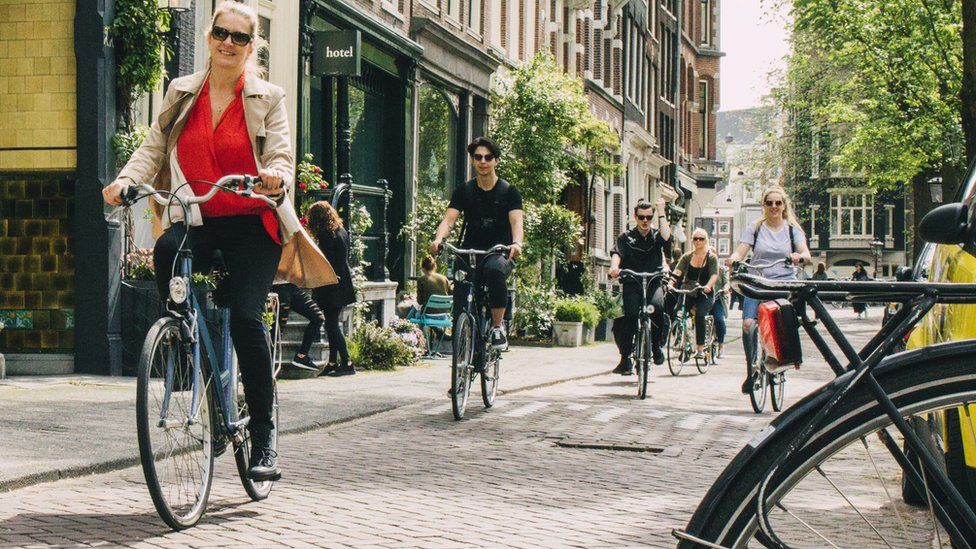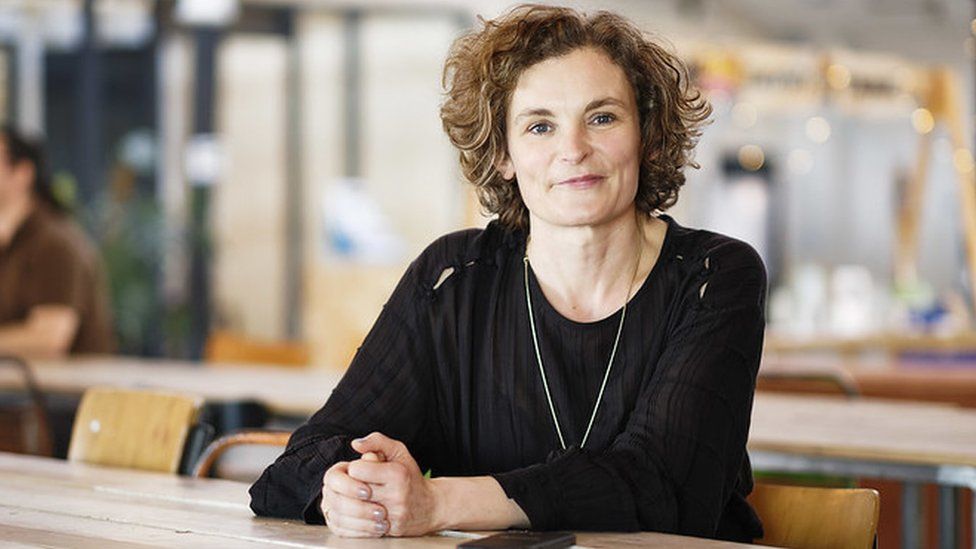Can Amsterdam make the circular economy work?

At United Repair Centre (URC), located next to the popular indoor food market Foodhallen in Amsterdam, Bakri Zaitoun is busy repairing the sleeve of a dark blue Patagonia puffer jacket.
Mr Zaitoun, a tailor from Syria who arrived in the Netherlands in 2018, is among eight refugees working as tailors at URC, which was founded last year to help extend the lifespan of clothing by fixing garments for brands and their customers.
Through a translator Mr Zaitoun explains that he has been a tailor for 25 years, but when he first arrived in the Netherlands he had to do all sorts of jobs. I asked him if it’s good to be tailoring again and he gives me a big smile.
Mr Zaitoun’s work is a small part of Amsterdam’s effort to become a circular economy.
A traditional industrial economy uses raw materials to make products which are discarded when they are no longer wanted, sometimes before the end of their useful lives.
The circular economy aims to break the link between economic activity and using up the earth’s resources. This may involve reusing, repairing, and sharing materials and products.
“Circularity is the hottest topic in the fashion industry right now,” says Thami Schweichler, chief executive at URC, an organisation he set up through his social enterprise Makers Unite, a creative textile platform.
“Every brand is looking at how they can be sustainable. Repairs will be part of the future of circularity for brands.”
There needs to be a systematic solution if change is to happen, he says. “It’s not going to happen through the consumer.”
Currently working with five brands including Patagonia, Scotch & Soda and Decathlon, companies send garments needing to be repaired to URC, which aims to fix goods within a week.
Turning around over 400 repairs a week, or roughly 20,000 a year, Mr Schweichler says the target is to reach 200,000 repairs per year by 2026.
Swelled by the rise of fast fashion, the clothing industry is known to be one of the most wasteful sectors, with three-quarters of our clothing ending up burned or buried in landfill, according to the World Economic Forum.
According to the Ellen MacArthur Foundation, clothing production doubled from 2000 to 2015 while there was a 40% drop in the amount of time clothing was worn.
While sustainability is on the agenda across many countries, in the Netherlands the government has set out bold plans to make the economy circular as quickly as possible.
In 2020 the Amsterdam declared itself the first city in the world to commit to building a circular economy, focusing on food and organic waste streams, consumer goods, and the built environment.

In seven years’ time Amsterdam plans to have halved its use of new raw materials. By 2050, the ambition is to be fully circular – relaying only on used and recycled materials.
That will be a big challenge for the construction industry, which is responsible for more than 30% of the extraction of natural resources and 25% of solid waste generated in the world.
One Dutch start-up, Madaster, is hoping to make a small dent in those statistics.
It has created an online registry capturing the materials used in Amsterdam’s buildings, as well as information about how they can be reused at the end of their life.
“The built environment uses a lot of materials and energy to create products,” says director Pablo van den Bosch. “Instead of waste and make, if we can instead reuse, it’s good for carbon emissions and good for decreasing waste.”
He says Madaster worked together with the Amsterdam authorities to create a digital overview of the buildings across the city. “If the city wants to redevelop an area they have insights into what materials they can save and perhaps use the materials already there instead of tearing it down.”


He points to the Olympic office in Amsterdam Zuid, which was completely refurbished rather than knocked down. “Natural stone was removed from the façade and used for flooring in the same building.”
Despite innovations like this, there is a long way to go.
The Circular Economy Progress Report 2022 by PBL Netherlands Environmental Assessment Agency found that while “policy efforts thus far have laid a foundation and developed a structure for a circular economy in the Netherlands… the Dutch economy still functions mainly in a linear fashion”.
“I’m afraid that the country and the city aren’t meeting targets,” says Willem van Winden, professor of urban economic innovation at Amsterdam University of Applied Sciences.
“The problem is that circular model and practices right now are costlier than linear ones. Unless the government implements stricter measures I’m afraid it will not happen. You need massive investment to make circular economy happen. A lot of businesses won’t make the transition unless legislation forces them to.”
Nevertheless, Amsterdam is setting up initiatives to encourage start-ups to make a bigger splash in the circular economy sector.
One initiative launched together with AMS Institute and venture capital accelerator Rockstart is Amsterdam Circular, a two-month programme designed to help 20 early-stage firms find funding.
“There was a clear need for the city to support early-stage start-ups and scale up financing,” says Guy Vincent, programme lead at Amsterdam Circular. “The programme is designed to support start-ups developing circular solutions in areas such as food, energy, mobilisation, construction and climate resilience.”
He says start-ups in the circular economy space face more challenges than other new firms.
“They are typically higher risk with lower profits as they can be testing new business models that are more complex and often not proven. Traditional VCs can be hesitant to invest in them. We want to try and find ideal financing models for circular companies. Co-financing is needed, i.e. private sector and a blend of public funds.”
Dutch electronics manufacturer Fairphone is one company that has managed to establish itself in the circular economy space.
It encourages its customers to keep their phones as long as possible and makes the phones relatively easy to fix.

“Keeping the phone in longer use is the highest impact you can make in this product category,” says Eva Gouwens, chief executive of Fairphone.
She points out that 75% of carbon emissions happen at production.
“The average lifetime of a device is two to three years. If we can extend to at least every five years, then you only need half the materials.”
Fairphone also offers a recycling programme, encouraging customers to hand in their old phone in return for at least €50. “We can use modules or at least components for repairing other devices. Many phones are sat in drawers or go to landfill,” she says.
Prof van Winden is encouraged by the companies developing circular models, but has this observation about the circular economy: “For now it’s mainly the upmarket segments and they’re often expensive products for richer people.”
